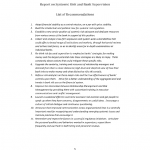
The 2007-2009 financial crisis was a systemic collapse – a sudden collapse of asset prices and the failure or near-failure/rescue of almost all large financial institutions. The United States has not witnessed a systemic collapse since the 1930s, and many thought it was impossible for the United States to have such an event, given the apparent advances in risk management that preceded it. However, the collapse occurred and was very large, damaging to the real economy and extremely expensive to resolve. A desire not to let such an event happen again pervades the body politic, indeed is demanded by many. But preventing such an event is neither easy nor costless. Financial crises typically follow large economic booms. While such booms may be characterized as bubbles in retrospect, they are extremely popular while they are occurring. The Federal Reserve has long seen its mission against inflation “to take away the punch bowl just when the party is getting good”; if it now becomes the systemic risk regulator it must be prepared to do the same against rising systemic risk, using tools beyond monetary policy. This is likely to be unpopular unless the ground is extremely well prepared and broadly understood. We return to this threshold problem in more detail below.
